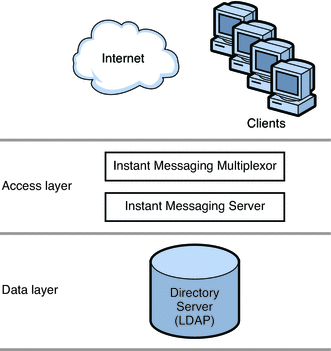Two-tiered Instant Messaging Architecture
A two-tiered architecture splits the Instant Messaging server deployment into two layers: an access layer and a data layer. In a simplified two-tiered deployment, you might add one or more multiplexors and servers to the access layer. The multiplexor acts as a proxy for users, and relays messages to the Instant Messaging server. The data layer holds the Instant Messaging server database and Directory servers. Figure 20–1 shows a simplified two-tiered Instant Messaging architecture.
Figure 20–1 Simplified Two-tiered Instant Messaging Architecture

Two-tiered architectures have advantages over one-tiered architectures that can impact your sizing decisions. Two-tiered architectures:
-
Are easier to maintain than one-tiered architectures
-
Enable the offloading of load-intensive processes like SSL, message reprocessing
-
Are easier for growth management and you can upgrade your system with limited overall downtime
Sizing Your Multiplexing Services
When you size your multiplexor, the calculation is based on your system load, particularly the number of concurrent connections the multiplexor needs to handle.
In addition, you must:
-
Add CPU or a hardware accelerator for SSL if appropriate.
-
Add memory to the machine if the multiplexor is being configured on it.
-
Add capacity for load balancing and redundancy, if appropriate.
One or more of each type of machine should still handle peak load without a substantial impact to throughput or response time when you plan for redundancy in your deployment.
- © 2010, Oracle Corporation and/or its affiliates
